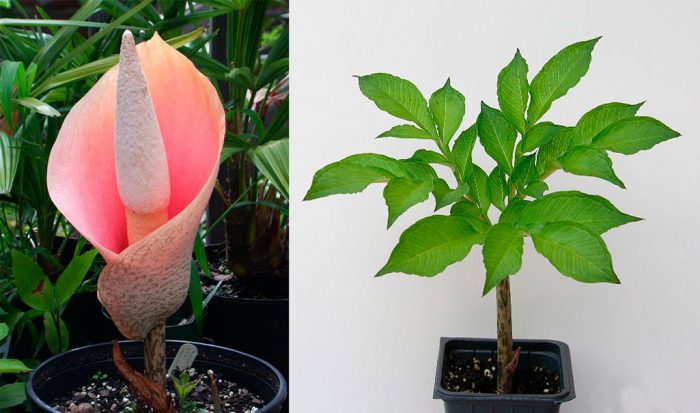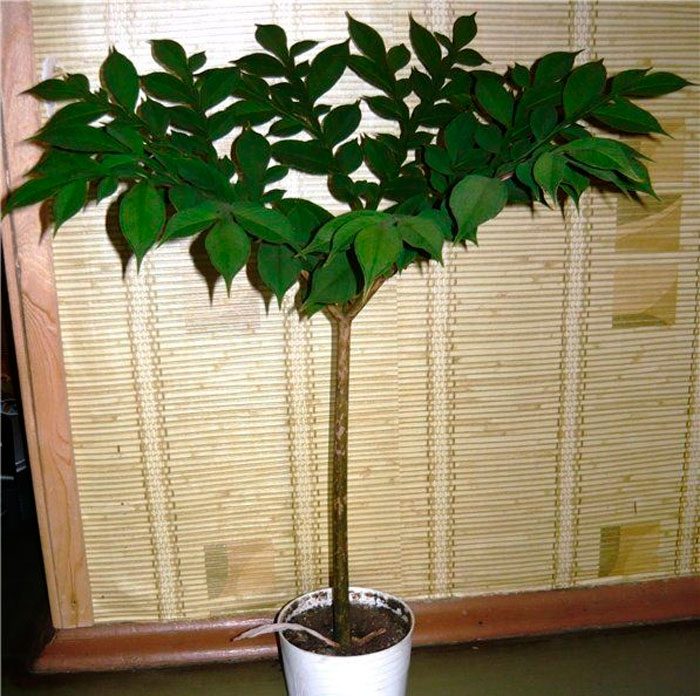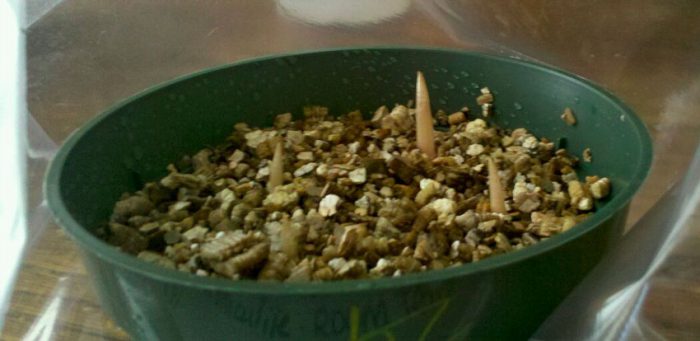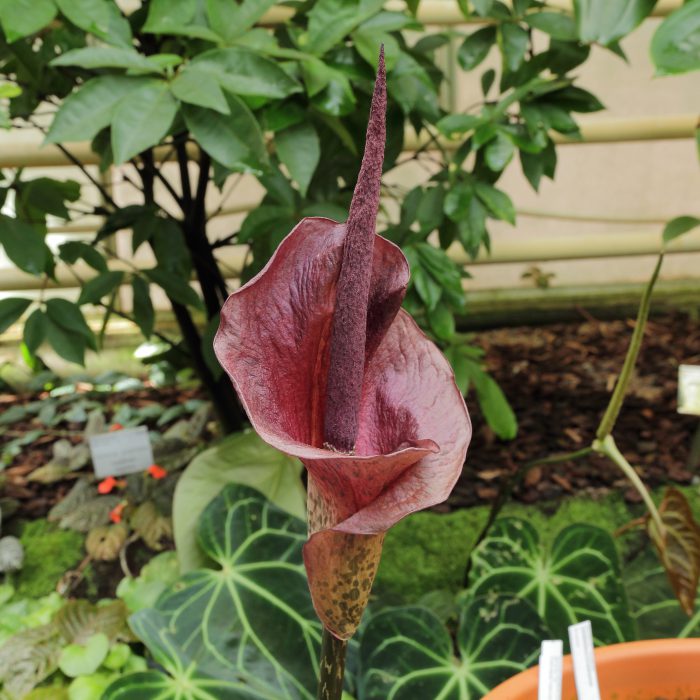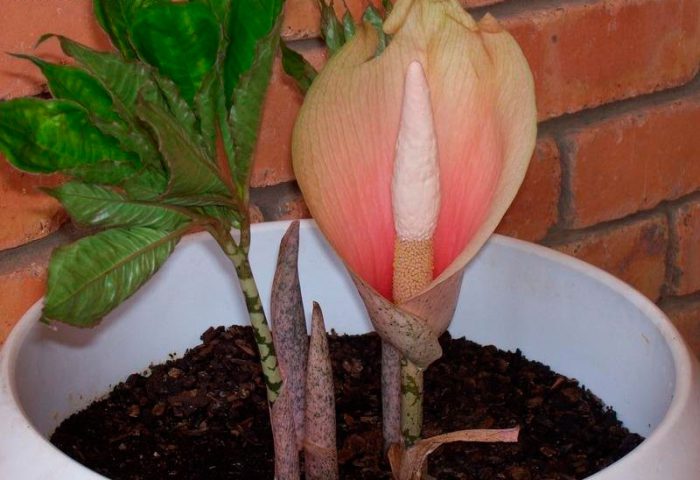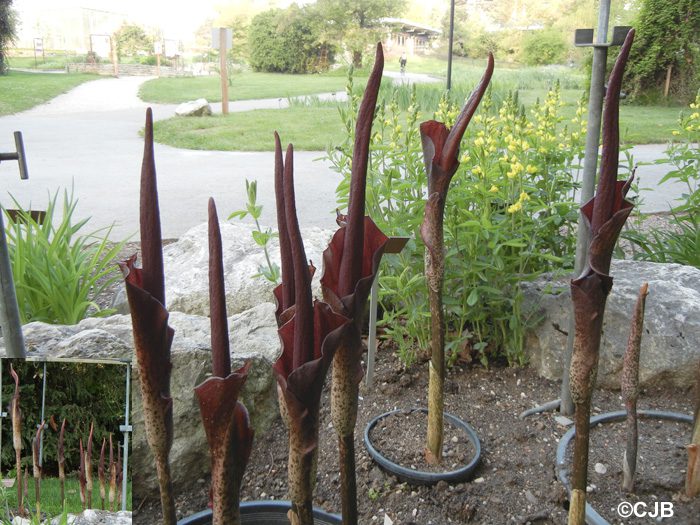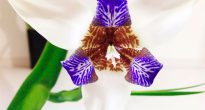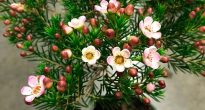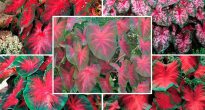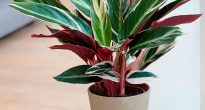Deciduous plant amorphophallus (Amorphophallus) belongs to the aroid family (Araceae). It comes from Indochina. The name of this genus consists of Greek words, so "Amorpho" means "formless" and "Phallus" - "offspring, escape". The plant was so named because of the appearance of the cob inflorescence.
This plant is ephemeroid (short-lived). So, his rest period differs in its duration, and it lasts more than six months. In the ground, it grows a tuber, which is similar in size to a grapefruit, and it weighs about 5 kilograms. A green, rather thick stem that looks like a palm trunk grows from just such a tuber. Only one complex half-meter leaf plate grows on the trunk. It is tinted greenish brown and has whitish dots on its surface. The leaf is tripartite and twice pinnately dissected. There is a hollow petiole.
The lifespan of such a leaf plate is only a few months. So, it grows, as a rule, in the last weeks of March, and in mid-October it turns yellow and dies off. Each subsequent year, the leaf grows slightly higher and becomes more and more dissected.
The development of a flower occurs after the end of the dormant period and before a new leaf grows. The plant blooms for about half a month, but even before new roots grow, it will stop. During the flowering period, the size of the tuber becomes much smaller. And all because a large amount of nutrients are consumed for the growth and development of a flower, which are taken from the tuber. In this regard, after the plant has faded, it will again have a short dormant period (about 3-4 weeks). After it ends, the leaf plate will begin to grow. It happens that the dormant period that comes after flowering lasts almost a year (until next spring). In the event that the flower is pollinated, then after the flowering ends, the seed will begin to grow, consisting of fleshy berries in which the seeds are located. Moreover, in the case of fruit development, the mother plant dies. This plant is also called "cadaveric flower". This is because it has a unique scent that is very similar to that of a decaying mouse carcass or rotten fish. However, this aroma does not emanate from him too long, only 1 or 2 days. Thus, the plant notifies pollinating insects that the flower has opened. Male flowers, as a rule, open a little later than female flowers, in this regard, the plant rarely self-pollinates. For pollination, it is necessary that at least 2 plants begin to bloom at the same time.
Amorphophallus care at home
Illumination
Needs bright lighting, but at the same time it should be diffused.
Temperature regime
In the warm season, the usual room temperature suits him. During the rest period, coolness is needed (from 10 to 13 degrees).
Humidity
Needs high humidity. It is necessary to systematically moisturize the plant from the sprayer.
How to water
During the period of intensive growth, watering should be abundant. At the same time, do not allow water to end up on the tuber during watering. When the leaves die off, watering should be reduced.
Top dressing
When fresh seedlings begin to grow, you need to fertilize 2 times a month, using mineral and organic fertilizers (alternately). You also need to remember that such a plant simply needs a large amount of phosphorus. In order for the tuber to gain mass in a relatively short time, systematic feeding will be required, while the fertilizer should consist of phosphorus, nitrogen and potassium, which must be taken in a ratio of 3: 1: 2 or even 4: 1: 1. If the tuber is quite large, then it is recommended to pour humus into the purchased soil for aroids (1 part). Before applying fertilizer to the soil, experts advise watering it well.
Dormant period
Such a plant simply needs a rest period. In the process of preparing for wintering, all the leaves die off. For this period, it is recommended to rearrange the flower pot in a dark and fairly cool place. Systematic moistening is required. In the last days of March, it is necessary to transplant the tubers, using new pots of a larger size than the previous ones. If rot appears on the tuber, then it should be removed from the soil. Take a very sharp knife and carefully cut the affected part. Then you need to process the cut with chopped charcoal and leave the tuber for 1 day in the open air to dry. Then amorphophallus can be planted in fresh soil mixture. A large number of gardeners are advised not to leave tubers for storage in the substrate. After the leaves completely die off, you must carefully remove the tubers from the container, remove the substrate from them and carefully examine. Then you need to separate the daughter nodules. If there are dead roots and rotten areas, then they should be cut with a very sharp knife. Places of cuts are treated with a strong solution of manganese potassium. After that, the tubers must be stored in a dark, dry and warm place.
Transplant features
The transplant is carried out at the end of the rest period. To prepare the soil mixture, it is necessary to combine humus, peat, sod and leafy soil, as well as sand, which must be taken in equal proportions.
Reproduction methods
You can propagate by seeds, children, and also divide the tuber.
Most often propagated by children. The dormant period begins after the foliage of a given plant withers. It is at this time that the tubers must be pulled out of the container, all the substrate removed from them and the daughter nodules must be separated. For storage, they are placed in a rather dark, always dry and warm (from 10 to 15 degrees) place (for the whole winter). Landing takes place in March or April.
It is also quite possible to split the tuber, but only the one that has sprouted buds is suitable for such a procedure. It should be remembered that at least 1 such kidney must be present on each division. Cutting should be done very carefully, taking care not to hurt the kidneys. Next, you need to process the sections, and for this, crushed charcoal is used. Leave the cuttings in the open air to dry for 24 hours. After that, plant in a soil mixture. Watering at first should be done with extreme caution.
Seed propagation is very rarely used. Such amorphophallus begins to bloom only after a few years.
Pests and diseases
As a rule, this plant is resistant to pests, but aphids or spider mites can settle on a young leaf. If you water very abundantly, rot may appear on the tubers.
If the leaf begins to dry out, this means that the plant either does not have enough light, or watering is very poor. If the color of the leaf acquires a great contrast, then this indicates a lack of light.
Video review
Main types
Amorphophallus cognac (Amorphophallus konjac)
The shape of the tuber resembles an oblate ball, while its diameter is 20 centimeters. The leaf petiole reaches 80 centimeters in length, it is painted in a dark olive color, and on its surface there are light as well as dark spots. Cirro-dissected leaves are colored deep green. Peduncle length can vary from 50 to 70 centimeters. The ear has a blanket that can be 25 to 30 centimeters long. The length of the ear reaches half a meter, and during the flowering process it can heat up to 40 degrees. Has a reddish purple or burgundy color. Has a very unpleasant, pungent odor. This plant, when grown at home, usually only blooms, and does not produce fruits.
Amorphophallus bulbifer
The tuber has a hemispherical shape, and reaches from 7 to 8 centimeters in diameter. There is 1 petiole leaf, which reaches 100 centimeters in length. It has a dark olive color, and there are spots of a lighter shade on its surface. The leaf plate is divided into segments, tripartite, and has a bulb at its base. As a rule, the length of the peduncle does not exceed 30 centimeters. And the length of the cob cover is 10–12 centimeters. It has a dirty green color with pinkish specks on the surface. The coverlet is slightly longer than the cob. When grown indoors, as a rule, the plant does not bear fruit, but only blooms.
Amorphophallus Rivera (Amorphophallus rivieri)
The diameter of the tuber can vary from 7 to 25 centimeters. The petiolate leaf plate is 40 to 80 centimeters long. On its surface there is a pattern of spots of brown and white color. In diameter, such a three-times dissected sheet can reach 100 centimeters. The segments into which the leaf is divided are pinnately dissected. Segments belonging to the second order have an elliptical-oblong shape and a sharpening in the upper part. There are convex green veins. Peduncle height can be up to 100 centimeters. The length of the bedspread is 30 centimeters. The coverlet is shiny, ovoid along the edge; its front surface is colored light green. The cover is 2 times shorter than the cob. As a rule, in indoor conditions such a plant only blooms, and the fruits are not formed.

